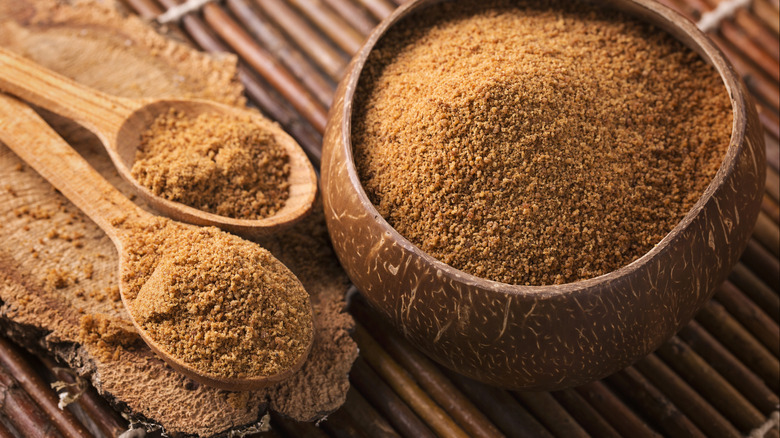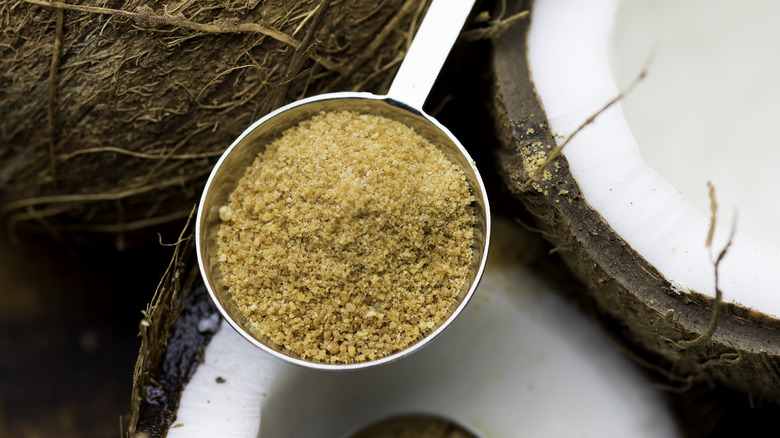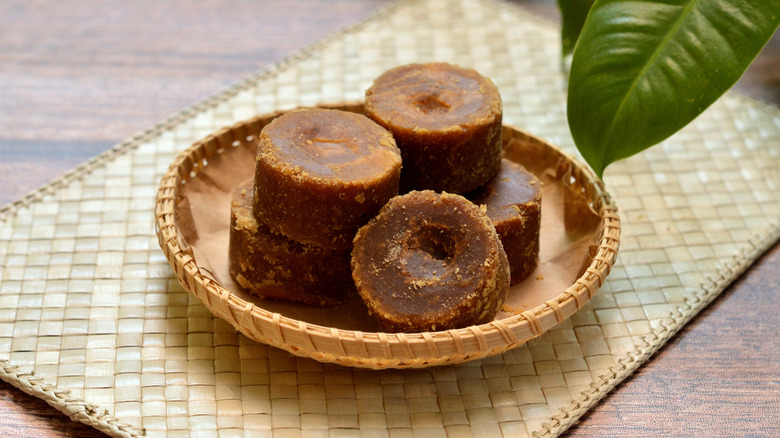Are Palm Sugar And Coconut Sugar The Same Thing?
If you've been whipping up homemade pad Thai for dinner, then you've probably seen palm sugar listed in the recipe's ingredients. You may have wondered: What exactly is palm sugar, and can you sub in a few tablespoons of coconut sugar from that bag in the kitchen pantry instead?
Indeed, the world of sugar is as varied as it is sweet. While palm sugar and coconut sugar are both natural sweeteners extracted and boiled down from the sap of flowers on trees, the two sugars are not the same. While a coconut tree is a type of palm and both plants are part of the Arecaceae family, the trees differ greatly in the type of fruit they produce, their root systems, and even the texture of their bark (you'll likely recognize some palm trees as those with a scaly exterior and fanned-out leaves compared to the smooth trunk of a coconut tree).
Coconut trees exclusively produce coconuts, while other palm trees don't necessarily bear fruit (though some do produce fruits like dates). However, both trees have blossoming flowers from which the sap is harvested to make particularly complex, deep-flavored sugar with notes of caramel, maple, and honey, similar to the flavors of brown sugar, but less intense and overly sweet. Palm sugar is made from the sap of flowers growing on palm trees, while coconut sugar is made via similar extraction methods but from the stems of the coconut tree's budding flowers, resulting in subtle flavor differences and uses.
How the two sugars differ
Both palm and coconut sugar are relatively unrefined forms of sugar, which retain their nutrients and are less saccharine sweet compared to granulated white table sugar from sugar cane or sugar beets, which is often more refined and processed. As such, both forms of sugar are often more expensive than table sugar.
While coconut sugar is technically a type of palm sugar, palm sugar can come in a range of forms and flavor profiles. With the recent popularity of coconut products, including coconut oil, milk, and flakes, these days you're more likely to find granulated coconut sugar in the baking aisle of large retailer grocery stores. Unlike other coconut derivatives made from the meat of the fruit, since coconut sugar is derived from the flowers, it does not have a coconut flavor. Instead, the taste is more akin to the floral notes of caramel and honey.
Both sweeteners are widely used in Southeast Asian cuisine, including traditional Thai, Indonesian, and Indian dishes, drinks, and desserts. They can be found in Asian grocery stores in solid blocks (also referred to as "jaggery"), pastes with a similar texture to honey, and granulated crystal forms. While coconut sugar typically has a brown color, palm sugar can range from a golden to grayish-black hue. The taste is different too, with palm sugar often being more smoky and deep, compared to subtler coconut sugar — and it will often add a bit more nuance and flavor depth to your recipes.
Ways to use palm and coconut sugar
Palm sugar and coconut sugar are unique from one another, yes, but they can often be swapped for one another in recipes. To get acquainted with the two sugars' nuances, take a trip to your local Asian supermarket and keep both sugars on hand to cook with.
The crystallized form of both sugars will likely not be as fine as table sugar, so if you plan on subbing in either palm or coconut sugar when baking muffins, you may need to run the sugar through a few pulses in the food processor to achieve a finer granulation size and texture. If you're subbing a couple tablespoons of palm sugar for granulated sugar in pad Thai, it will add a lovely flavor depth to the recipe. However, if you're baking with either palm or coconut sugars, it may be important to account for the fact that these sugars will be less sweet.
Cooking with palm or coconut sugar paste is a great option for easily scooping and whisking into punchy salad dressing like miso tahini dressing, and a variety of curries to develop the flavor complexity of these dishes. If you purchase the blocks of either sugar, you might need to slice, chop, or even melt it prior to incorporating it into your recipe. However, when making hot drinks, the block and granulated forms are especially convenient and are great when dissolved in hot liquid to make chai tea or a sweetened turmeric latte.


